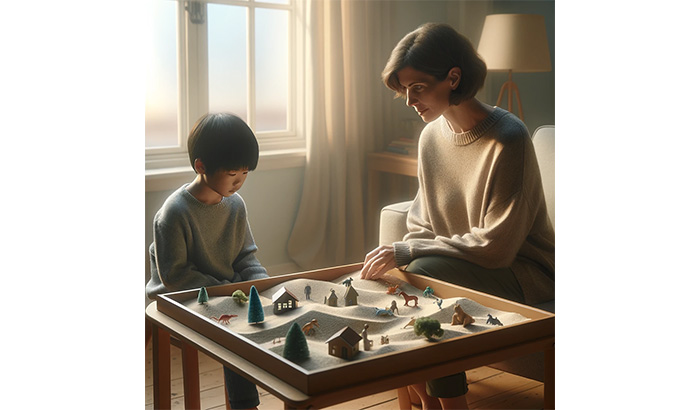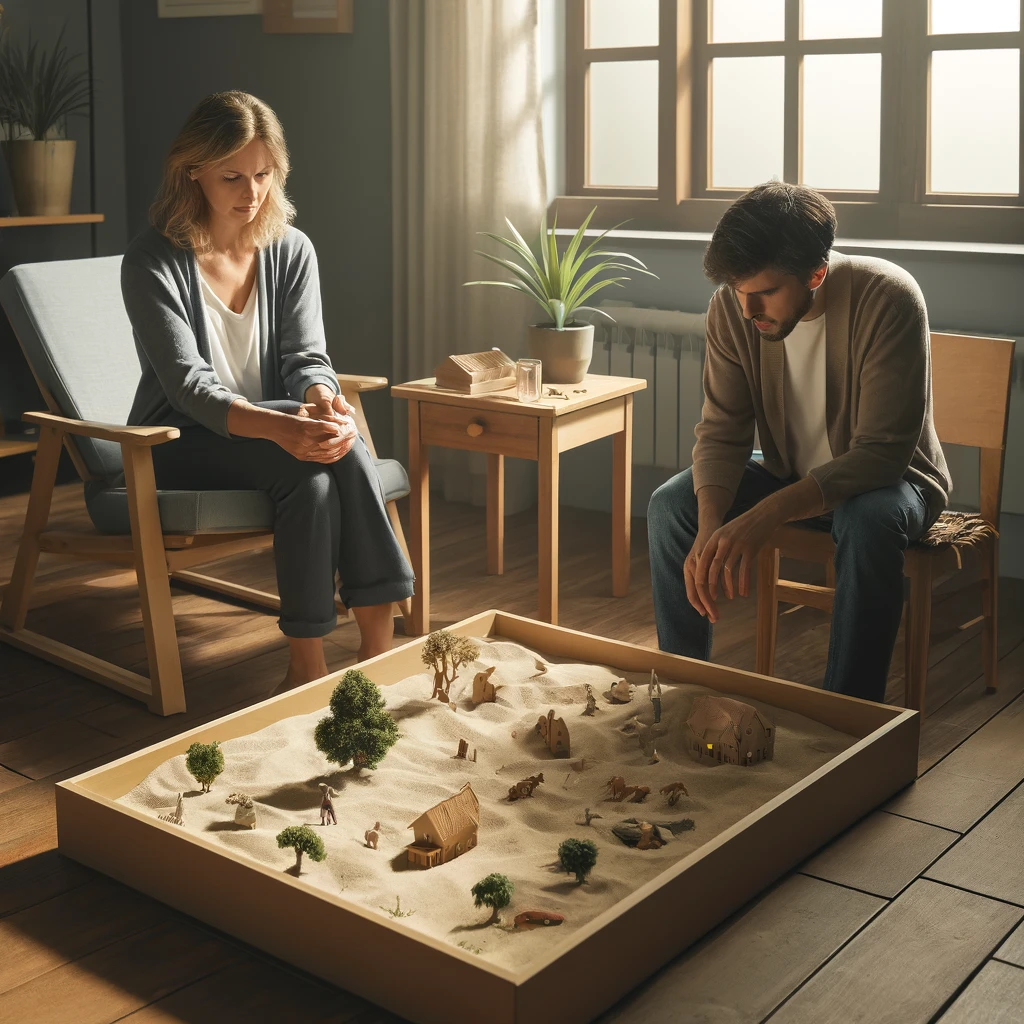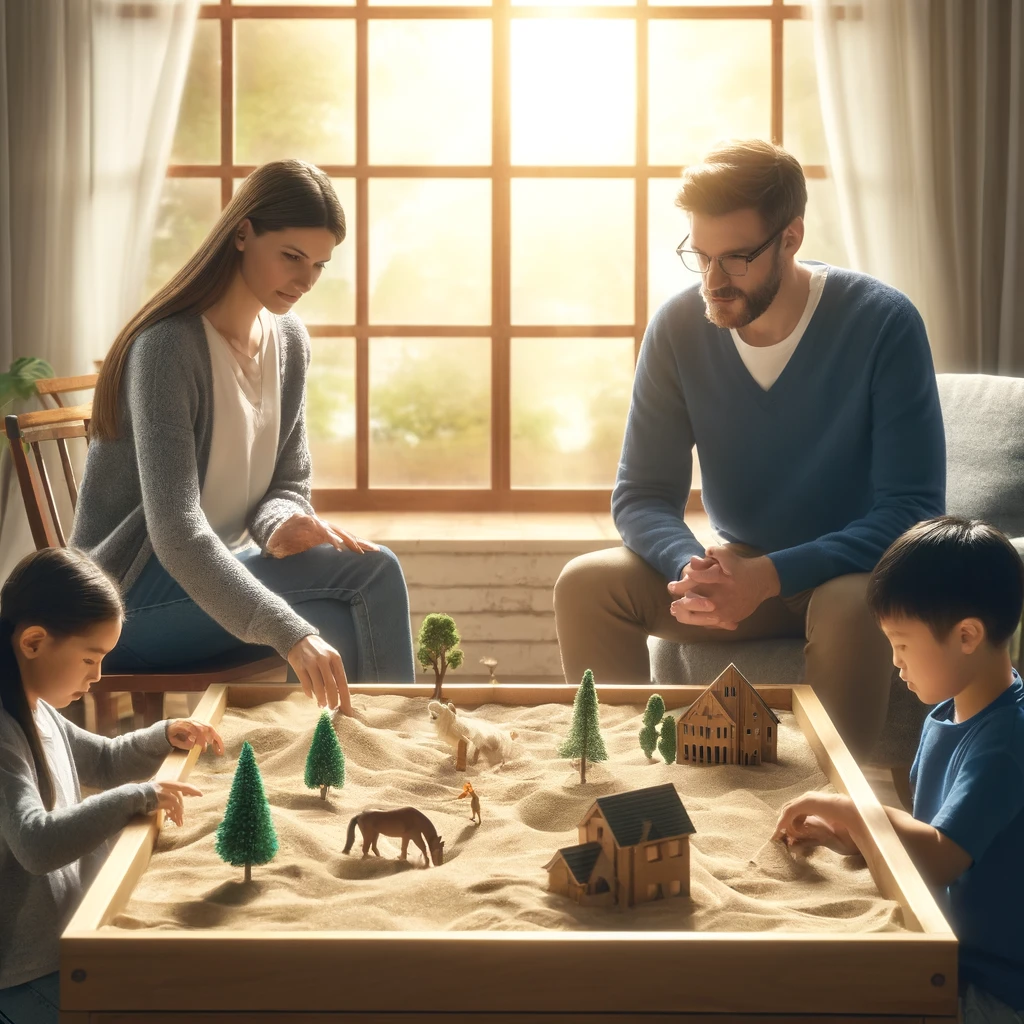
When people experience trauma or anxiety, it often feels like they carry a heavy load every day. They might struggle with overwhelming emotions, constant worry, and painful memories that don’t seem to fade away.
For many, finding a therapy that provides relief becomes a critical step toward healing and better mental health. This is where sandtray therapy comes into play.
Imagine a small box filled with sand where worlds emerge and stories unfold, revealing the deepest emotions and unspoken words of those who dare to explore its bounds. This is the essence of sandtray therapy, a unique therapeutic approach that transforms simple sand into a powerful medium for healing.
People grappling with trauma and anxiety find a voice in the miniature landscapes they create, each grain of sand working together to build a bridge back to peace and mental clarity. In this article, we dive into the heart of sandtray therapy, discovering how it unlocks emotional expression and fosters recovery for children and adults overwhelmed by their minds.
Join us as we explore how this gentle yet impactful method helps heal hearts and minds, providing a fresh perspective on overcoming life’s toughest challenges.
What is sandtray therapy?
Sandtray therapy involves a simple yet profound approach to healing. In this therapy, clients create scenes in a sandbox filled with sand using a variety of miniature objects and figures. This process allows them to express thoughts and emotions that might be hard to articulate with words alone.
The therapist observes and guides the client through the reflections on the scenes they create, unlocking emotional responses and facilitating more profound understanding and healing.
Sandtray therapy opens up a world where clients lead their healing process. They build tangible representations of their inner worlds by selecting and positioning figurines and objects. This hands-on involvement empowers them, offering a sense of control over the narrative of their own lives.
As they arrange and rearrange their sandy scenes, they recognize patterns and themes that recur in their thoughts and behaviors, gaining insights often elusive in more conventional talk therapies.
The therapist supports this discovery process, providing gentle guidance without leading the client, ensuring the insights and breakthroughs come authentically from the individual’s understanding and pace of healing. This fosters a nurturing environment where clients feel safe and creatively engaged in tackling their emotional challenges.
The origins of sandtray therapy
The method dates back to the 1920s when British pediatrician Margaret Lowenfeld introduced sand play in her work with children. Later, Dora Kalff, a Swiss therapist, further developed the technique, incorporating Jungian psychology into what she called “sandplay.” Today, therapists use sandtray therapy with adults and children, adapting the approach to suit various psychological needs.

How sandtray therapy addresses trauma
Trauma disrupts a person’s sense of safety and normalcy. For those who have survived traumatic events, memories and emotions related to the trauma often remain hidden or suppressed because they are too painful to face directly.
Sandtray therapy provides a safe, controlled environment where individuals explore these difficult emotions indirectly by projecting their inner world onto the sandtray. Therapists find that as clients arrange and rearrange the objects and sand, they often enact scenarios that reflect their personal experiences and emotions.
This externalization makes it easier for them to confront and process feelings they might otherwise avoid. The tactile nature of the sand also plays a role, offering a soothing, grounding effect that helps reduce anxiety during the session.
The sand acts as a buffer, allowing clients to approach their most distressing memories at a pace that feels manageable. This method not only aids in processing trauma but also helps build resilience as individuals learn to navigate and reshape their emotional landscapes.
Treating anxiety disorders with sandtray therapy
Anxiety disorders cause persistent and excessive worry that interferes with daily activities. For those living with these disorders, sandtray therapy acts as a powerful tool for managing anxiety. The creative and open-ended nature of the therapy allows clients to explore their fears and anxieties symbolically.
By manipulating the figures and the sand, clients gain control over the representation of their anxieties, which can translate into a greater sense of control in real life. Additionally, the session provides a space for clients to practice calming techniques and confront their fears with the support of a therapist.
Over time, this practice leads to significant reductions in overall anxiety levels, as evidenced by numerous clinical studies and client testimonials. This hands-on approach also enables clients to externalize their internal struggles, making them more manageable and less intimidating.
The physical act of molding and reshaping the sand mirrors their ability to reshape their thought patterns, enhancing their coping strategies in everyday life.
The benefits of sandtray therapy
One of the key advantages of sandtray therapy is its ability to help clients express themselves non-verbally. This is particularly beneficial for those who find it hard to put their feelings into words, including young children and individuals who are withdrawn or silenced by their trauma and anxiety.
The non-verbal nature of the therapy ensures that it is accessible to a wide range of clients, regardless of age or verbal ability. Therapists also note that sandtray therapy accelerates healing by enabling clients to address multiple issues simultaneously.
For example, a single session might reveal interconnected insights into a client’s relationships, self-image, and past traumas. This holistic approach helps clients better understand their mental health and more effective coping strategies.
Engaging with the sand and figures stimulates the sensory pathways, which often calms the mind and reduces stress. This sensory engagement can be especially healing for those who experience anxiety and stress-related disorders, providing a peaceful outlet for emotional regulation.
The therapeutic process in sandtray therapy
A typical sandtray therapy session begins with the therapist inviting the client to build a world in the sandtray using various figures and objects. As the client works, the therapist observes silently, noting the choice of objects, their arrangement, and any changes the client makes along the way.
After the client has finished, the therapist and client discuss the scene, exploring the symbolism and emotional significance of the created world. This discussion can lead to powerful revelations and insights as the client makes connections between the sandtray scenario and their own life experiences.
Challenges and considerations in sandtray therapy
While sandtray therapy offers numerous benefits, it requires a skilled therapist trained to guide the process effectively. The therapist must be able to interpret the non-verbal cues and symbols created in the sand, a skill that involves sensitivity and experience.
The therapy may not be suitable for everyone, and clients need to find a therapeutic approach that feels comfortable and effective for their specific needs.
It’s also crucial for the therapist to maintain a non-judgmental and supportive presence, as clients may reveal very personal and sometimes painful parts of their life story through the sandtray. This therapy demands a setting where confidentiality and emotional safety are paramount to encourage true expression and facilitate healing.

A quick recap
As we wrap up our exploration of sandtray therapy, it’s clear that this innovative approach offers more than a box of sand and toys — it provides a sanctuary where silence speaks louder than words. Individuals battling the shadows of trauma and the grip of anxiety discover a powerful ally in the miniature worlds they create.
Each session lays down another stepping stone toward healing, making what once seemed overwhelming suddenly manageable. Sandtray therapy stands out for its effectiveness and the compassionate space it offers, allowing people to reconstruct their experiences and regain control over their emotions.
With every sand scene crafted, individuals draw closer to reclaiming their inner peace and strength, proving that sometimes, the simplest tools can pave the way to profound healing. As more therapists embrace this method, countless more will likely find solace and understanding through their own sands of change.
Strong Lives Counseling Is Here To Support You!
Exploring sandtray therapy has unlocked new pathways for addressing anxiety, depression, and other emotional challenges across all ages.
Whether facing these struggles yourself or watching a loved one go through tough times, it’s crucial to know that help and hope are right here at Strong Lives Counseling.
Here, we customize sandtray therapy to fit our client’s unique emotional landscapes. Our skilled and empathetic therapists commit to providing a supportive environment where individuals of any age can express themselves, explore their emotions, and develop strong coping strategies.
We recognize the complexities of mental health and dedicate ourselves to aiding every person on their path toward recovery and personal growth.
Struggles like anxiety and depression do not have to dominate your life or that of someone you care about. Discover the transformative power of sandtray therapy.
Call Strong Lives Counseling today at 385.432.5183 to learn more about our services and how we’re ready to help you or your loved one build resilience and achieve a brighter outlook on life. Let’s overcome these obstacles together and lay the groundwork for a hopeful, stronger future.
